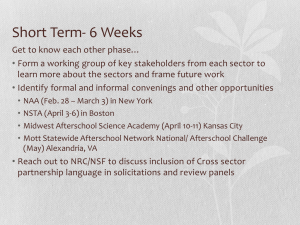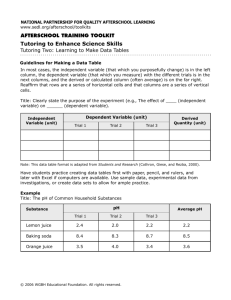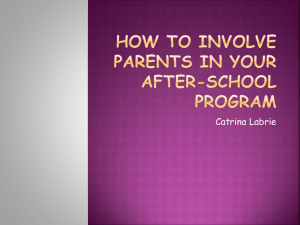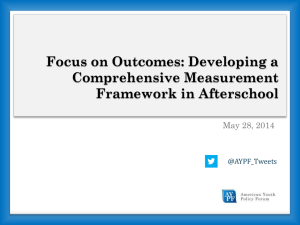Issue Brief No. 57 October 2012
advertisement
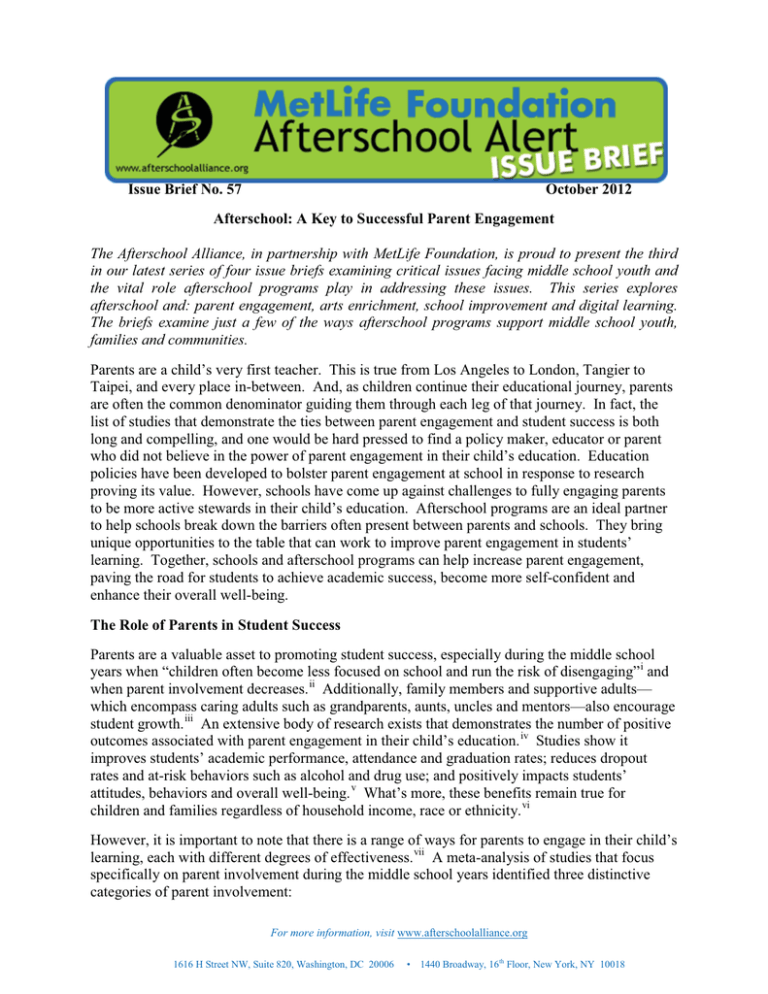
Issue Brief No. 57 October 2012 Afterschool: A Key to Successful Parent Engagement The Afterschool Alliance, in partnership with MetLife Foundation, is proud to present the third in our latest series of four issue briefs examining critical issues facing middle school youth and the vital role afterschool programs play in addressing these issues. This series explores afterschool and: parent engagement, arts enrichment, school improvement and digital learning. The briefs examine just a few of the ways afterschool programs support middle school youth, families and communities. Parents are a child’s very first teacher. This is true from Los Angeles to London, Tangier to Taipei, and every place in-between. And, as children continue their educational journey, parents are often the common denominator guiding them through each leg of that journey. In fact, the list of studies that demonstrate the ties between parent engagement and student success is both long and compelling, and one would be hard pressed to find a policy maker, educator or parent who did not believe in the power of parent engagement in their child’s education. Education policies have been developed to bolster parent engagement at school in response to research proving its value. However, schools have come up against challenges to fully engaging parents to be more active stewards in their child’s education. Afterschool programs are an ideal partner to help schools break down the barriers often present between parents and schools. They bring unique opportunities to the table that can work to improve parent engagement in students’ learning. Together, schools and afterschool programs can help increase parent engagement, paving the road for students to achieve academic success, become more self-confident and enhance their overall well-being. The Role of Parents in Student Success Parents are a valuable asset to promoting student success, especially during the middle school years when “children often become less focused on school and run the risk of disengaging” i and when parent involvement decreases. ii Additionally, family members and supportive adults— which encompass caring adults such as grandparents, aunts, uncles and mentors—also encourage student growth. iii An extensive body of research exists that demonstrates the number of positive outcomes associated with parent engagement in their child’s education. iv Studies show it improves students’ academic performance, attendance and graduation rates; reduces dropout rates and at-risk behaviors such as alcohol and drug use; and positively impacts students’ attitudes, behaviors and overall well-being. v What’s more, these benefits remain true for children and families regardless of household income, race or ethnicity. vi However, it is important to note that there is a range of ways for parents to engage in their child’s learning, each with different degrees of effectiveness. vii A meta-analysis of studies that focus specifically on parent involvement during the middle school years identified three distinctive categories of parent involvement: For more information, visit www.afterschoolalliance.org 1616 H Street NW, Suite 820, Washington, DC 20006 • 1440 Broadway, 16th Floor, New York, NY 10018 x School-based involvement, such as volunteering at school and interaction between teachers and parents; x Home-based involvement, such as help with homework and other academic-related activities at home; and x Academic socialization, which includes communication between parents and children that conveys the importance of education and encourages future academic and occupational goals. viii “Research shows that parent involvement in schools has multiple positive impacts: student success increases, along with teacher morale and overall school quality. It’s like the secret ingredient in the recipe for educational success!” The analysis found that while parent involvement as a whole is associated with positive gains in academic achievement among middle schoolers, activities falling under the category of academic socialization demonstrated the strongest relationship. ix A separate multi-year case study on parent engagement in middle school offered policy recommendations associated with academic socialization after evaluating the —Betsy Landers, effects of various modes of engagement. Recommendations National PTA included helping parents better communicate their hopes to President their child, strengthening relationships and developing trust between parents and school staff, ensuring parents are able to attend school events, and working with parents to further parent engagement efforts. x Why Is It So Hard for Schools to Fully Engage Parents? For more than four decades, through the Elementary and Secondary Education Act (ESEA), policy makers have embraced the importance of parent engagement and have worked to incorporate it into education policy. The No Child Left Behind (NCLB) Act of 2001 formalized inclusion of parent engagement, providing a specific definition of parental involvement that explicitly delineates how parents are able to participate in their child’s education at school. xi Recognizing the important role of parents, the Department of Education’s “Parental Involvement Guidance” stated, “When schools collaborate with parents to help their children learn and when parents participate in school activities and decision-making about their children’s education, children achieve at higher levels. In short, when parents are involved in education, children do better in school and schools improve.” xii More recently, the Department of Education included family engagement as a “…good parenting and turnaround principle for school improvement efforts under the family involvement in ESEA flexibility waivers. xiii schools are essential if children are going to However, despite considerations and efforts to involve parents, flourish and fulfill schools face multiple challenges to improve parent engagement their dreams.” levels. Lack of time on the part of both parents and staff, and lack of staff training in working with parents have been —Arne Duncan, identified as barriers. Others include cultural, socioeconomic Secretary of Education and language differences between parents and staff, as well as parent attitudes toward schools, particularly in schools serving majority low-income households and schools with higher levels For more information, visit www.afterschoolalliance.org 1616 H Street NW, Suite 820, Washington, DC 20006 • 1440 Broadway, 16th Floor, New York, NY 10018 2 of minority enrollment. xiv The Department of Education’s 2006-2007 “Parent and Family Involvement in Education” survey found that just 55 percent of parents were “very satisfied with the way school staff interacts with parents.” xv In addition, although the NCLB law includes language to boost parent engagement in schools, many in the education field have argued that the law has not increased engagement, with critiques ranging from too strong a focus on compliance to not enough guidance on how to better involve parents. xvi Afterschool Programs as a “Broker” Between Parents and Schools Afterschool programs are uniquely situated to address obstacles schools face and help improve parent engagement. For instance, community-based afterschool programs—that are also often staffed by members of the community—may be viewed as more approachable by parents, thereby filling the role of “broker” between parents and schools. xvii In this role, programs are able to offer guidance and assistance to parents who may be overwhelmed by their school system; provide parents with information on how to better communicate with school staff; and help coordinate and facilitate parent-teacher meetings. xviii Afterschool programs also have the ability to be creative and tailor their supportive services to the distinctive needs of their community. For example, afterschool programs are able to keep their doors open into the evening hours and on weekends to facilitate parent involvement; draw parents and families in by providing counseling and other “But all these wraparound services; offer English classes and translation innovative programs assistance for families who are not fluent in English; and provide xix and expanded incentives for participation, such as food and meals. opportunities will not, The advantage of afterschool programs addressing parent in and of themselves, engagement is two-fold. Not only do afterschool programs have make a difference if the ability to break down barriers schools face when working to each of us, as parents increase parent engagement, as outlined above, but afterschool and as community programs also provide additional opportunities to encourage parent involvement and positively impact children’s academic leaders, fail to do our success, behavior and overall well-being. xx Benefits associated part by encouraging with parent engagement in afterschool programs, such as excellence in our fostering student success, are very much in line with benefits children.” associated with parent engagement in their child’s education during the regular school day. xxi In addition, parent engagement —President Barack in afterschool programs bolsters participation of youth in Obama programs, supports the quality of afterschool programs, and is a constructive influence on parent involvement at home and at school. xxii Afterschool Programs Encourage Parent Participation A research review examining the characteristics and activities that effectively support parent engagement found that the most successful programs share a number of key characteristics. Many successful afterschool programs: For more information, visit www.afterschoolalliance.org 1616 H Street NW, Suite 820, Washington, DC 20006 • 1440 Broadway, 16th Floor, New York, NY 10018 3 x Promote a welcoming environment, x Address misconceptions that may be held by teachers and parents about the role of parent engagement, x Use resources toward supporting increased parent involvement, x Understand the effect of children’s home environment on their academic performance, x Organize the program structure to encourage parent engagement, and x Provide parents with the information and tools to support their children’s academic success. xxiii Many afterschool programs are actively incorporating the above measures into their programming and working to implement practices that engage parents through: 1. Helping open the channels of communication and understanding between parents and children by offering counseling and family supportive services that encourage student success. The Family Empowerment Program (FEP) in Miami, FL, works to help grow children’s positive communication and “Parents, schools, and social skills, and places a strong focus on developing children’s communities working self-worth, empathy, self-discipline, responsibility and ability together create to collaborate. The afterschool program also combines a meaningful structured learning environment with free individual and family partnerships that counseling services for parents and children to practice problem ultimately lead to solving and communication skills. FEP offers learning sessions to provide students and parents the opportunity for family significant gains in bonding and improving family communication. Parents are student achievement taught how to set positive boundaries, establish healthy and success.” standards for behaviors and recognize warning signs of risky behavior. In addition, the program helps to facilitate parent —John D. Barge, involvement in their child’s school. An evaluation of the State School program found that students significantly improved coping with Superintendent, conflict and understanding their self-worth, and parents made Georgia positive gains in conflict management and bonding with their child. Of children participating in the program who were at risk of or who had a first criminal offense, 98 percent remained arrest-free. 2. Building trust with families who may feel disengaged and disconnected from the school system and providing resources to help parents become active stewards in their child’s education. The Sunnyside Community Services Beacon Community Center (Beacon) in Sunnyside, NY, actively reaches out to immigrant families in their community, addressing the barriers that make it difficult for these families to become actively involved in their child’s education. In addition to providing academic enrichment activities—such as life-skills development, career awareness, community building, recreation and the arts—the Beacon offers adult English for Speakers of For more information, visit www.afterschoolalliance.org 1616 H Street NW, Suite 820, Washington, DC 20006 • 1440 Broadway, 16th Floor, New York, NY 10018 4 Other Languages (ESOL) classes to help parents gain proficiency in English, multilingual workshops to help parents adapt to the policies and expectations of New York City schools, and events such as potluck dinners and performances to foster positive multigenerational and multicultural interactions. The Beacon is open until 10 p.m. on weeknights and all day on Saturday to ensure working parents are able to participate in the program’s numerous activities. 3. Leveraging program resources to incentivize parent participation. Kid Power, Inc.’s VeggieTime Project in Washington, D.C.—a program that focuses on nutrition, health, the environment and civic participation—encourages family involvement through its gardening and cooking activities. Parents and children work together to harvest vegetables, learn healthy eating habits and cook healthy meals. In addition, the VeggieTime Project distributes a portion of the produce grown to families participating in the program. Family surveys found 100 percent of parents rated VeggieTime’s programming as “excellent” or “good.” Evaluations of children participating in the VeggieTime Project are also favorable. For example, 99 percent of students were promoted to the next grade, students’ average “good behavior” score increased from 67 percent to 81 percent and students’ average nutritional knowledge score increased from 61 percent to 75 percent. 4. Soliciting and incorporating parent feedback and suggestions into program structure to gain buy-in and engender participation. The Committee for Hispanic Children and Families @ PS/MS 279 in New York, NY, encourages parent engagement through a science and math program that is for both children and parents. Students and their parents learn side-by-side in science, technology, engineering and math (STEM) activities, such as building a wind cannon, producing lip gloss and learning about weather patterns. Located in a heavily Latino community, the Committee for Hispanic Children and Families conducts lessons in both English and Spanish to encourage greater family participation. The program also solicits feedback from parents and offers workshops based on parent interests, such as citizenship and English language classes for adults. In addition, translation services for parents who need assistance during parent-teacher conferences are also provided. Self-evaluations have revealed gains in parent involvement and student knowledge of STEM. Conclusion There is little dispute regarding the benefits that parent engagement brings to a child’s academic success. Policy makers, school administrators and teachers are conscientiously working to ensure parents are involved in their child’s education. However, these endeavors are challenged by existing obstacles between parents and schools, such as limited resources and time, language barriers, and levels of trust. Afterschool programs are able to transcend these divides, offering an environment where parents can feel at ease; providing parent-related activities and family services during times more accessible to working parents; offering resources to help parent-child communication; and providing parents with the tools to become more empowered in their involvement with their child’s education. Together with schools, afterschool programs are strengthening parent engagement efforts and helping provide the foundation necessary to make sure that children are on the path to educational success. For more information, visit www.afterschoolalliance.org 1616 H Street NW, Suite 820, Washington, DC 20006 • 1440 Broadway, 16th Floor, New York, NY 10018 5 i Valdovinos D’Angelo, A., et. al. (2012). School Engagement Among Parents of Middle School Youth. Chapin Hall Issue Brief. Chapin Hall at the University of Chicago. Chicago, IL. Retrieved from http://www.chapinhall.org/research/report/building-system-support-evidence-based-home-visitation-programsillinois-early-findi. ii Juvonen, J., et. al. (2004). Focus on the Wonder Years-Challenges Facing the American Middle School. RAND Education. Santa Monica, CA. Retrieved from http://www.rand.org/pubs/monographs/2004/RAND_MG139.pdf. iii Henderson, A. and Mapp, K. (2002). A New Wave of Evidence: The Impact of School, Family, and Community Connections on Student Achievement. Austin, TX: National Center for Family & Community Connections With Schools. Retrieved from http://www.sedl.org/connections/resources/evidence.pdf; Ferguson, C., et. al. (2008). The School-Family Connection: Looking at the Larger Picture-A Review of Current Literature. National Center for Family and Community Connections with Schools at SEDL. Austin, TX. Retrieved from http://www.sedl.org/connections/resources/sfclitrev.pdf. iv Jeynes, W. (2012). A Meta-Analysis of the Efficacy of Different Types of Parental Involvement Programs For Urban Students. Urban Education; Fan, W. and Williams, C. (2009). The effects of parental involvement on students’ academic self-efficacy, engagement and intrinsic motivation. Educational Psychology. Houston, TX. Retrieved from http://mrbaileyhhhs.edublogs.org/files/2011/03/Parent-Involvement-and-Student-Motivationz6wkvy.pdf; Rosenzweig, C. (2001). A Meta-Analysis of Parenting and School Success: The Role of Parents in Promoting Students’ Academic Performance. Paper presented at the Annual Meeting of the American Education Research Association, Seattle, WA. Retrieved from http://www.eric.ed.gov/ERICWebPortal/search/detailmini.jsp?_nfpb=true&_&ERICExtSearch_SearchValue_0=ED 452232&ERICExtSearch_SearchType_0=no&accno=ED452232. v Duran, M., et. al. (2010). Taking Leadership, Innovating Change: Profiles in Family, School, and Community Engagement. National Family, School, and Community Engagement Working Group. Retrieved from http://www.hfrp.org/publications-resources/browse-our-publications/taking-leadership-innovating-change-profilesin-family-school-and-community-engagement; Henderson, A. and Mapp, K. (2002). A New Wave of Evidence: The Impact of School, Family, and Community Connections on Student Achievement. Austin, TX: National Center for Family & Community Connections With Schools. Retrieved from http://www.sedl.org/connections/resources/evidence.pdf; Dervarics, C. and O’Brien, E. (2011). Back to school: How parent involvement affects student achievement. The Center for Public Education. Retrieved from http. ://www.centerforpubliceducation.org/Main-Menu/Public-education/Parent-Involvement/Parent-Involvement.html vi Henderson, A. and Mapp, K. (2002). A New Wave of Evidence: The Impact of School, Family, and Community Connections on Student Achievement. Austin, TX: National Center for Family & Community Connections With Schools. Retrieved from http://www.sedl.org/connections/resources/evidence.pdf. vii Fan, X. and Chen, M. (2001). Parent Involvement and Students’ Academic Achievement: A Meta-Analysis. Educational Psychology Review, Vol. 13, No. 1. Retrieved from http://www.springerlink.com/content/p72731506kh74595/. viii Hill, N. and Tyson, D. (2009). Parental Involvement in Middle School: A Meta-Analytic Assessment of the Strategies That Promote Achievement. Developmental Psychology, Vol. 45, No. 3. Retrieved from http://www.apa.org/pubs/journals/releases/dev453740.pdf. ix Hill, N. and Tyson, D. (2009). Parental Involvement in Middle School: A Meta-Analytic Assessment of the Strategies That Promote Achievement. Developmental Psychology, Vol. 45, No. 3. Retrieved from http://www.apa.org/pubs/journals/releases/dev453740.pdf. x Valdovinos D’Angelo, A., et. al. (2012). School Engagement Among Parents of Middle School Youth. Chapin Hall Issue Brief. Chapin Hall at the University of Chicago. Chicago, IL. Retrieved from http://www.chapinhall.org/research/report/building-system-support-evidence-based-home-visitation-programsillinois-early-findi. xi Section 9101 (32) ESEA. xii U.S. Department of Education. (2004). Parental Involvement: Title I, Part A—Non-regulatory Guidance. xiii Offutt, T. (2012). States Asked To Improve Consultation With Parents. Education Daily. xiv U.S. Department of Education. (1996). Survey on Family and School Partnerships in Public Schools, K-8. National Center for Education Statistics, Fast Response Survey System. Washington, D.C. Retrieved from http://nces.ed.gov/surveys/frss/publications/98032/index.asp. For more information, visit www.afterschoolalliance.org 1616 H Street NW, Suite 820, Washington, DC 20006 • 1440 Broadway, 16th Floor, New York, NY 10018 6 xv Herrold, K. and O’Donnell, K. (2008). Parent and Family Involvement in Education, 2006-07 School Year, From the National Household Education Surveys Program of 2007. National Center for Education Statistics, Institute of Education Sciences, U.S. Department of Education. Washington, D.C. Retrieved from http://nces.ed.gov/pubs2008/2008050.pdf. xvi Cavanagh, S. (2012.) Parental Engagement Proves No Easy Goal. Education Week. xvii Harvard Family Research Project. (2010). Partnerships for Learning: Promising Practices in Integrating School and Out-of-School Time Program Supports. xviii Harvard Family Research Project. (2010). Partnerships for Learning: Promising Practices in Integrating School and Out-of-School Time Program Supports; Harris, E., et. al. (2012). Families and Expanded Learning Opportunities: Working Together to Support Children’s Learning. Harvard Family Research Project. Retrieved from http://www.hfrp.org/publications-resources/publications-series/ncsl-harvard-family-research-project-brief-serieselo-research-policy-practice/families-and-expanded-learning-opportunities-working-together-to-support-children-slearning. xix Horowitz, A. and Bronte-Tinkew, J. (2007). Building, Engaging, and Supporting Family and Parental Involvement in Out-of-School Time Programs. Child Trends. Washington, D.C. Retrieved from http://www.childtrends.org/Files//Child_Trends-2007_06_19_RB_ParentEngage.pdf; Kreider, H. and Westmoreland, H. (2011). Promising Practices for Family Engagement in Out-of-School Time. Charlotte, NC. xx Kreider, H. and Westmoreland, H. (2011). Promising Practices for Family Engagement in Out-of-School Time. Charlotte, NC.; Harris, E. and Rosenberg, H. (2012). Families and Expanded Learning Opportunities: Working Together to Support Children’s Learning. Harvard Family Research Project. Retrieved from http://www.hfrp.org/publications-resources/publications-series/ncsl-harvard-family-research-project-brief-serieselo-research-policy-practice/families-and-expanded-learning-opportunities-working-together-to-support-children-slearning. xxi Horowitz, A. and Bronte-Tinkew, J. (2007). Building, Engaging, and Supporting Family and Parental Involvement in Out-of-School Time Programs. Child Trends. Washington, D.C. Retrieved from http://www.childtrends.org/Files//Child_Trends-2007_06_19_RB_ParentEngage.pdf. xxii Kreider, H. and Westmoreland, H. (2011). Promising Practices for Family Engagement in Out-of-School Time. Charlotte, NC. xxiii Ferguson, C., et. al. (2008). The School-Family Connection: Looking at the Larger Picture-A Review of Current Literature. National Center for Family and Community Connections with Schools at SEDL. Austin, TX. Retrieved from http://www.sedl.org/connections/resources/sfclitrev.pdf. For more information, visit www.afterschoolalliance.org 1616 H Street NW, Suite 820, Washington, DC 20006 • 1440 Broadway, 16th Floor, New York, NY 10018 7
